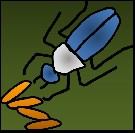Crop management practices
The following crop management practices should be used:
-
early sowing/planting: to avoid the peak period of the insect;
-
synchronized planting: farmers have to plant their rice at about the same time so that the insect does not always find young plants to build up its population;
-
fertilizer doses: avoid over-doses as this would lead to too profuse leaf formation;
-
destruction of wild rice, O. longistaminata: this is a perennial weed in which the insect survives during the dry season and transfers to young rice plants at the beginning of the rainy season;
-
preservation of Paspalum scrobiculatum (see Figure below): this is a host plant for gall midge parasites: Platygaster diplosisae and Aprostocetus procera.
Using crop management practices to control gall midge requires a certain organization among farmers. They may find difficulties in implementing the activities requiring joint action (e.g. synchronized planting), or because of socio-economic problems (e.g. meeting the requirements to be able to sow/transplant at the same time).
Biological control
Biological control means trying to preserve the life of useful insects:
Predators: red ants, crab spiders, wolf spiders and jumping spiders eat adult and larval midges;
Parasitoids: the most common parasitoids of gall midge are Platygaster diplosisae and Aprostocetus procera. Both are small wasps living on the Paspalum scrobiculatum weed. This is the reason why this weed is useful in the integrated control.
Indeed, during the dry season, Platygaster diplosisae and Aprostocetus procera develop on Paspalum scrobiculatum and increase their population. During the rainy season, when the rice is in place and African rice gall midge appears, they attack and destroy the gall midge. They lay their eggs inside the midge eggs, larvae and pupae, thus killing the gall before it reaches the adult stage. Platygaster diplosisae attacks the eggs and the larvae of gall midge from the outside and Aprostocetus procera only attacks the pupa inside the plant. So, if farmers destroy Paspalum scrobiculatum, they destroy at the same time the useful insects Platygaster diplosisae and Aprostocetus procera. Thus, Paspalum (the main host plant for these insects) has to be preserved, whereas Oryza longistaminata (which hosts African rice gall midge itself) has to be destroyed.
Control with insecticides
The use of insecticides to control gall midge does not seem a good option, especially because the two control methods mentioned above are effective. They not only preserve useful insects, but also do not harm the environment.
Control through varietal resistance
This is using rice varieties that are resistant to the pest or tolerant to the presence of the pest. This ability to resist can result from the morphological constitution discouraging the insect (hard plant tissue, bad taste, repulsive odor, leaf characteristics not appropriate to hatching, etc.). All these different characteristics may be inherent to the plant or introduced through breeding.
The two cultivated rice species Oryza sativa (Asian) and O. glaberrima (African) both have gall-midge-resistant varieties. Resistant varieties from the African species are: TOG 7106, TOG 7206 and TOG 7442 released in Mali, Côte d’Ivoire and Nigeria, respectively. Several varieties of the O. sativa are resistant: Cisadane, BW348-1 and TOS 14519, released in The Gambia. WARDA is developing interspecific resistant varieties from crosses between O. glaberrima and O. sativa.
Extract from PLAR-IRM Curriculum: Technical Manual (Wopereis et al., 2009)













